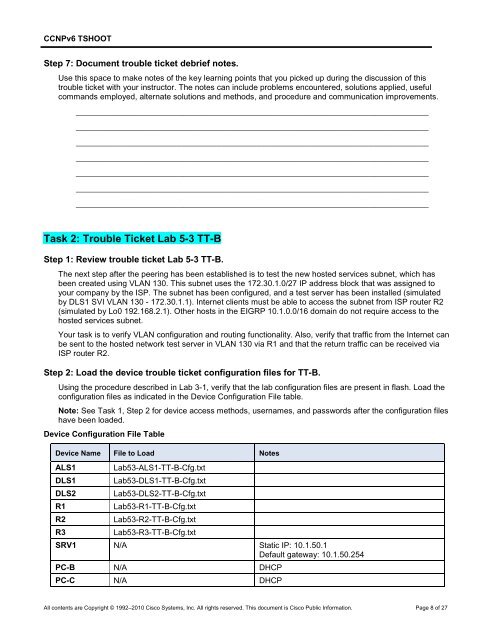CCNP TSHOOT 6.0 - The Cisco Learning Network
CCNP TSHOOT 6.0 - The Cisco Learning Network
CCNP TSHOOT 6.0 - The Cisco Learning Network
You also want an ePaper? Increase the reach of your titles
YUMPU automatically turns print PDFs into web optimized ePapers that Google loves.
<strong>CCNP</strong>v6 <strong>TSHOOT</strong><br />
Step 7: Document trouble ticket debrief notes.<br />
Use this space to make notes of the key learning points that you picked up during the discussion of this<br />
trouble ticket with your instructor. <strong>The</strong> notes can include problems encountered, solutions applied, useful<br />
commands employed, alternate solutions and methods, and procedure and communication improvements.<br />
_______________________________________________________________________________<br />
_______________________________________________________________________________<br />
_______________________________________________________________________________<br />
_______________________________________________________________________________<br />
_______________________________________________________________________________<br />
_______________________________________________________________________________<br />
_______________________________________________________________________________<br />
Task 2: Trouble Ticket Lab 5-3 TT-B<br />
Step 1: Review trouble ticket Lab 5-3 TT-B.<br />
<strong>The</strong> next step after the peering has been established is to test the new hosted services subnet, which has<br />
been created using VLAN 130. This subnet uses the 172.30.1.0/27 IP address block that was assigned to<br />
your company by the ISP. <strong>The</strong> subnet has been configured, and a test server has been installed (simulated<br />
by DLS1 SVI VLAN 130 - 172.30.1.1). Internet clients must be able to access the subnet from ISP router R2<br />
(simulated by Lo0 192.168.2.1). Other hosts in the EIGRP 10.1.0.0/16 domain do not require access to the<br />
hosted services subnet.<br />
Your task is to verify VLAN configuration and routing functionality. Also, verify that traffic from the Internet can<br />
be sent to the hosted network test server in VLAN 130 via R1 and that the return traffic can be received via<br />
ISP router R2.<br />
Step 2: Load the device trouble ticket configuration files for TT-B.<br />
Using the procedure described in Lab 3-1, verify that the lab configuration files are present in flash. Load the<br />
configuration files as indicated in the Device Configuration File table.<br />
Note: See Task 1, Step 2 for device access methods, usernames, and passwords after the configuration files<br />
have been loaded.<br />
Device Configuration File Table<br />
Device Name File to Load Notes<br />
ALS1 Lab53-ALS1-TT-B-Cfg.txt<br />
DLS1 Lab53-DLS1-TT-B-Cfg.txt<br />
DLS2 Lab53-DLS2-TT-B-Cfg.txt<br />
R1 Lab53-R1-TT-B-Cfg.txt<br />
R2 Lab53-R2-TT-B-Cfg.txt<br />
R3 Lab53-R3-TT-B-Cfg.txt<br />
SRV1 N/A Static IP: 10.1.50.1<br />
Default gateway: 10.1.50.254<br />
PC-B N/A DHCP<br />
PC-C N/A DHCP<br />
All contents are Copyright © 1992–2010 <strong>Cisco</strong> Systems, Inc. All rights reserved. This document is <strong>Cisco</strong> Public Information. Page 8 of 27

















